Transcript
Hi, I’m Peter from Plug & Play and I’ve been building and marketing websites for quite a long time. Over the 15 years that I’ve been working with clients to grow their businesses, I’ve been involved with over 400 website design and build projects and I know a good 300 ways how not to do it.
When our clients come to us for advice on their website, asking for help with their digital marketing performance, we often look at an array of digital marketing strategies. Within this topic there are a huge number of strategies that you could utilise.
Today, we’re going to cover what we consider to be the top two that apply to almost every business and can be hugely effective: search engine optimisation and conversion rate optimisation. As well as touching on channel marketing and personas.
So we’re going to start by discussing how to be found in Google. Although we’re discussing Google, the same principles apply to all the major search engines. Google has such a stronghold within the search sphere that other search engines follow a very similar course. If you focus on delivering for Google, your actions will also drive your search visibility in other search engines.
How does Google work?
So how does Google work? Lots of people claim to know how Google works and will inform you that the algorithm updates all the time. However over the last 20 years, Google hasn’t really changed that much. The algorithm shifts left to right a little bit but there are 3 core principles at the heart of the algorithm that has made it such a success.
The first principle is trust, which looks at the business and at the website and makes a judgement about your reputation based on your digital footprint. This moves us into the second principle which is contextual trust – what are you trustworthy for? Then finally, there’s specificity. How specific are you about a particular topic?
Google uses these 3 principles to decide what you should rank for and where you should rank.
For example, I trust my Mother but if I had a problem with my laptop she wouldn’t be the person I’d ask to fix it. Dave in our IT department, however, would be the perfect choice to help me. What we’re starting to see here is the nuance between trust and contextual trust. If I had a flower arranging emergency, my Mum would be abundantly qualified to help me out, but not so much with my laptop.
So when Google decides where to rank you for certain things, it’s essentially trying to replicate this offline process. So how can we influence our trust, contextual trust and specificity to improve our rankings?
Trust factors are really difficult to influence as they rely on inbound link building and the length of time your website has been active in Google. However your keyword specificity and how your website is built are both completely under your control and can have a huge influence on your rankings.
Picking keyword battles
A couple of things you need to think about when you want to rank more highly in Google is which battles you want to fight. This falls into a number of camps:
- You shouldn’t pick battles that are too big
- You shouldn’t pick so many battles that your resources are spread too thinly
To give you an example, I know a mortgage broker based in Woking. He’s an independent guy, lovely bloke, but he’s never going to appear in Google for the keyword mortgages. The major high street banks and institutions have a much greater level of trust and contextual trust, lots of inbound links with great online and offline footprints. There are 10 positions on page 1 of Google and there are over 10 high street banks. He’s going to stand a much better chance of ranking if he picks battles that he has a greater chance of success with. For example, he has a much larger chance of ranking for mortgage advisor in Guildford. So that explains a bit about the scale of keyword battles.
So what about the number of battles to enter? The key thing here is to be honest with yourself. Do I have the time and do I have the financial resources in order to focus on all these different keywords?
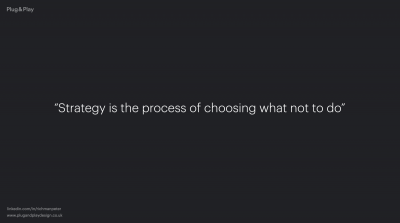
This feeds into the core business strategy of choosing what not to do. In this case, it couldn’t be more true. Focusing on what not to do should leave you with a small area to focus on to maximise your digital footprint, improve the number of people who are visiting your website, and subsequently the number of people who are enquiring and buying online.
Keyword selection: how a London based architect selected keywords to generate enquiries
What we did
To help talk through this in a bit more detail, I’m going to talk you through a case study. This case study happens to be an architecture firm in South London. They are a fantastic business and have a great team and great portfolio but their business was generating the majority of their business offline. People were coming to them because they’d heard of them or because they’d been recommended by a friend. While that’s great business, it’s one of those classics where you get all your clients via word of mouth because your online marketing isn’t working so you don’t have any inbound leads.
What we needed to do was to help them take all those great aspects about their business and show them to the world. They needed to show off what they were capable of.
We started by creating a keyword list, something you’ve probably done before where you work collaboratively as a group to create a list of keywords.
Minale + Mann have a number of different archetypes – they target both commercial and residential audiences and they have a number of different services such as architecture and interior design. Using these services and audiences as a start point, we built up a list of 50 or so keyword combinations and put them through a number of online tools.
We recommend Moz.com, SEMrush.com and Google Ads and you can run the lists through these tools to help generate much longer lists of the different variants. This will help you to figure out which variants are easiest to succeed with.
How we assess keywords
To expand on this I’m going to use commercial architects as a keyword, that’s the row that’s been highlighted here. Here you can see that commercial architects has a search volume of 50-100 searches per month. This number came from Moz but you can get similar statistics from Google Ads and the numbers will vary a little depending on the tool you use.
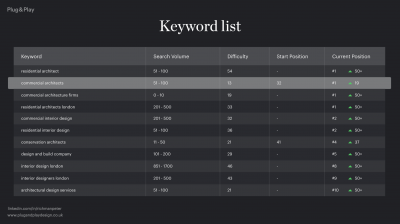
Looking at our start position in the table, you can see that we started with a ranking of 32 which means that Minale + Mann were on page 4 of Google.
Page 4 is better than nowhere. From a user perspective, page 4 won’t drive traffic but from a Google perspective it means that Google already recognises that they are a commercial architect. And so it’s a foundation that we can build on. As you can see here, there’s lots of other keywords that they don’t rank for at all.
So looking closer at our start position for the keyword commercial architect, above the table you can see the keyword commercial architects with a search volume of 50-100. But the metrics that I’d like to draw your attention to are the Minale + Mann domain authority and the page authority. These metrics come from moz.com.
What Moz does is they take the trust and specificity that Google uses to determine your rankings and they model how competitive you are based on your trust metrics, your inbound links, and how well built your website is.
Moz catalogues the Google search rankings for your search terms and tells you who is currently ranking on page 1 for that keyword. In this case, we can see the top 10 positions in Google for commercial architects at the start of the project, alongside the page and domain authority of each ranking competitor.
Looking at line 3 of the table, E2 architects you can see that they have a page authority and domain authority that is very similar to Minale + Mann. Suggesting that Minale + Mann should be able to compete for a 3rd or 4th place position in Google for this keyword. Although they weren’t currently ranking anywhere on page one for this keyword, their metrics were competitive.
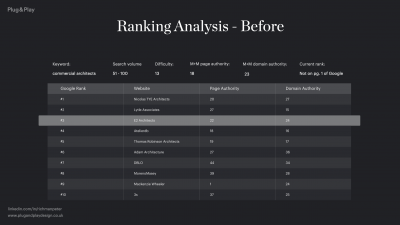
So why not? It’s because the specificity part of Google’s algorithm wasn’t being met. They had a page about commercial architects and content about commercial architects but because of the way the site was built and how things were represented in the code – the quality of the code and the quality of the website overall – they weren’t able to rank highly in Google.
Digital marketing results
So fast forward a few months and the new website has launched and you can see that they are now number 1 in Google. During this time Google changed their algorithm, which is why there has been so much change here. That jump from page 4 to the top of page one makes a transformational difference to the number of people that arrive on the website. As you can see here, this particular battle was chosen because the page authority and domain authority that we started with was comparable to their competitors. By improving their website they could leap frog above their competitors by changing the factors they have within their control.
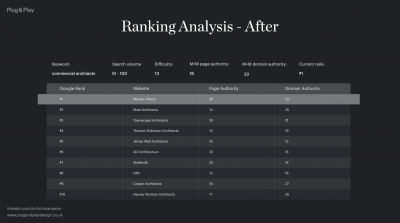
Keyword improvements at scale
The key to doing this successfully for any business is to do it on scale. Once we had our long list of keywords, we put them through our tools and selected around 50 keywords to focus on. These keywords can be chopped and changed as necessary based on the movement we see in rankings over time.
For example, if a keyword has gone from page 3 to page 2, we’ll focus on getting that ranking onto page 1 rather than throwing more resource at keywords showing no movement.
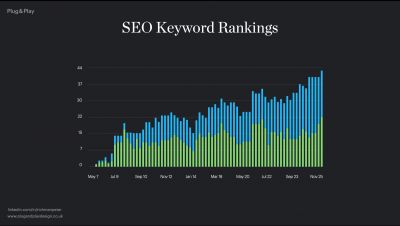
So what you’re looking at is a chart from moz.com. Each bar represents 1 week and the height represents the number of keywords on page 1 of Google. The blue aspect of the bar represents positions 1,2 and 3 in Google and the green bar represents positions 4-10.
What you can see on the left hand side of the chart is that they didn’t rank anywhere for these keywords when we started. However, they ranked for around 43 keywords at the time of making the chart which was around the middle of December. Of those 43 keywords, over half of them are in positions 1-3 in Google so it’s made a tremendous difference to Minale + Mann’s lead generation. This is a business that has gone from getting leads exclusively from word of mouth to opening up a new channel of lead generation, coming in on a Monday morning with 2-3 leads to follow up.
From a statistics perspective, they were generating quite a lot of traffic with their old website for their brand name. So they were getting a lot of brand related traffic. When we increased their traffic by 91% over that period, we almost doubled their traffic by introducing non-brand related searches. That equates to thousands of extra visitors each month. This in combination with a bounce rate reduction of 30% has increased the number of enquiries that they are receiving via their website.
We’ll be coming onto conversion in a little more detail shortly.
SEO tips for the construction industry
1. Research all the variations for keywords.
Start off with that short list, put them through Moz, SEMrush or Google Ads to create a longer list of written variants.
2. Consider the intent of your keywords as well.
For example, we’re a web design agency. We wouldn’t necessarily want to invest in appearing in Google for web designer as that suggests you’re looking for an individual or a freelancer. Therefore you wouldn’t be aligned with us when it comes to engaging offline. We want to engage in those battles where an individual has decided that they want an agency and are therefore more aligned with us and more likely to convert from visitor to enquiry.
Find out more on what makes a good keyword.
3. Think outside of the box.
With Minale + Mann we looked at the different types of projects they were undertaking. They had a number of conservation projects where the fees were very high and the projects were of scale. They had portfolio items that were a good match for these search phrases so they had a good chance of converting visitors. It happens that Google wasn’t reporting any search volume for conservation keywords at all so the search volume was likely to be small, however because the project value is so high and Minale + Mann were able to be very specific for it, although it would likely only deliver 1 or 2 leads a year, the likelihood of converting that lead into a successful client was very high. So it’s not necessarily always about playing big numbers.
4. Finally, invest in the tools you need to do this well.
Your competitors will be using these tools and agencies to review this stuff for them, so if you’re going to do this well you will need comparable tools to get the insights and help to determine the battles that you have a statistically significant chance of succeeding with.
Using customer acquisition cost models to track ROI
And this feeds into the customer acquisition cost model. That’s what you can see on the screen here and it takes us all the way from market penetration through to sales.
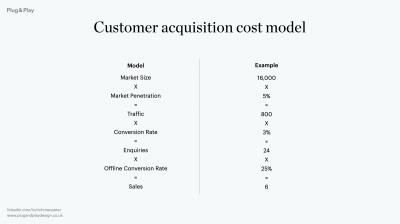
Running through from the top, the market size is the difference between appearing on Oxford Street or a side alley. Market size in the digital sense is the number of people doing the Googling for the search terms you want to appear for.
Therefore the market penetration is how highly you rank to receive the traffic visiting your website. To give you some insight here, if a website was ranking 5th in Google then it’s likely to get 8% of traffic. If there’s 100 people searching and they rank 5th, you’re going to get 8 visitors per month.
What you can see here is that market size x market penetration = website traffic.
Next is the conversion rate, so the percentage of website visitors turning into enquiries. What’s interesting about conversion rate is that it’s an area you have a surprising amount of control over and that’s what we’re going to come onto next.
Finally the traffic x conversion rate = enquiries
And enquiries x offline conversion rate = your sales.
How do we measure conversion rate?
So how do we increase the conversion rate?
The first thing you need to do is understand the conversion rate you should be going for and how the conversion rate you have compares to your competitors.
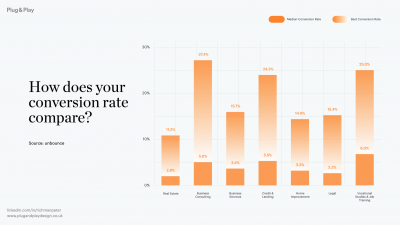
There’s quite a lot of websites out there with statistics on what a good conversion rate is. This happens to be from Unbounce but there’s other marketing oriented businesses such as Econsultancy that have statistics on this as well. You may find that there is a sector or a demographic that quite tightly aligns with your own business. We’d recommend starting off with an expectation of 2.5-3.5%.
If you are a brand leader with a highly specific product in a commodity market then your conversion rate is likely to be much higher. Also if you are very targeted with your marketing, the higher your conversion rate is likely to be – this is because your audience is more aligned with your product or service.
The wider you go with your marketing, the more your conversion rate will drop. That’s because more people who are further away from your brand or product will be finding your website. A 2.5-3.5% conversion rate is usually a good balance between the right quantity of traffic and the right aligned target audience to convert into paying customers. Good eCommerce websites typically have 4.5-7% conversion rate.
So start off with a reasonable estimate of your conversion rate or even better, your conversion rate from Google Analytics. Coming back to that customer acquisition cost model, you have a surprising amount of control and insight. You know what your offline conversion rate is, you know how many enquiries you’re getting so when you look at your own data or data from your contemporaries by looking at the market data we’ve just reviewed, you can start filling out your own customer acquisition cost model.
What influences conversion rate?
So what is influencing whether people engage with your website or not? This data is from Adobe who are a big software company in this space. 38% of users will leave a website if they don’t like the design. That’s the headline really. Broken out from that, Adobe found that engagement drops if the images won’t load, the website is too slow, or the content is too long.
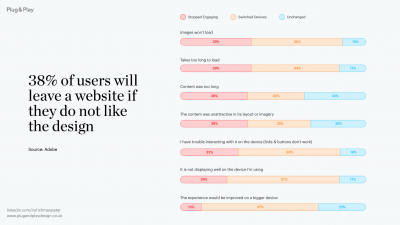
Businesses like Amazon and ASOS have invested so much money in making fast websites. They’ve really trained people to have no patience with the internet. In order for your website to have an impact, you really need to play to that.
Digital marketing tips
So what can you do about it?
1. Optimise website speed
One of the key things you should take away from this talk is that you need a website that is fast. The key action related to this is that you should be using a content delivery network. A content delivery network, or a CDN, edge hosts your website which means that more people can visit your website at the same time. Not only this, the server that’s serving the website to the customer is geographically closer to the point at which they’re accessing the website. As a result, the website appears to be much faster.
Services like Cloudflare offer free tiers for their CDNs and for many of the people listening today, the free tier would be an amazing upgrade to what you currently have. If you take nothing else away from this talk today, go and get a free Cloudflare account and get whoever manages your website to ensure that you’re deploying your website on a CDN.
2. Structure your website and content for the best conversion rate and SEO performance
The next thing to consider is the content architecture. Great websites rank well in Google for lots of pages that are not the homepage. If you have an array of services and products, each one of those pages should be considered a homepage when you’re writing content. When you’re curating content for the page, you need to ensure that the content can stand alone on its own as a homepage for that topic. From there, Google is much more likely to rank you for those individual search terms and pages. When Google teleports someone looking for a particular service in a particular location into your website, they’re not going to the homepage, they’re going to the most relevant page. Therefore they are much less likely to bounce or leave your website immediately after landing. If they are searching for interior designers in London and land on the homepage, that’s very inspecific. Whereas if they land on the interior designers in London page, that’s exactly what they’ve Googled for and are looking for and are more likely to convert.
3. Consider the design
Consider the design. You obviously have control over the design. As an agency we have an objective view over hundreds of websites and can see design patterns that work and help convert visitors into enquiries. You guys can look into this yourselves – there are a lot of design patterns available that can be applied to your website to improve conversion rate. It’s a huge topic that unfortunately we don’t have time to go into today.
4. Optimise the user experience
What you do need to do is provide consistent experience across all devices. Google ranks websites based on mobile first so what it does is it crawls your website as if it were a phone, looks at how the website resolves and is rendered, and looks at the quality of the site and the underlying code. Then it tweaks it for desktop. In order to rank highly on a desktop you need to rank highly on a phone – you can’t do one without the other
5. Allocate your marketing budget based on return on investment
Prioritise your investment based on the return you’ll likely see by using the customer acquisition cost model that we went through.
6. Stop any marketing activity that isn’t working
If it’s not working then stop – particularly if you’re using Google Ads. If you’re using the customer acquisition cost model properly you’ll be able to model how much you’re spending on Google Ads vs your sales to make commercially valid decisions about how much you spend.
Marketing examples from businesses in Construction
Minale + Mann – Architect
So what did we do for Minale + Mann?
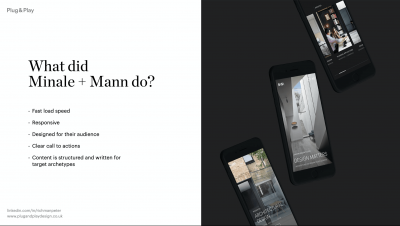
- We implemented Cloudflare CDN and ensured the website was loading quickly.
- We made the site responsive and made sure that the mobile and tablet view was optimised for the user.
- We focused the website and content on the target audience who are wealthy, aspirational people in London. These people are dreaming about doing up or building their own home and the website and content needed to resonate with them.
The structure and overall architecture of the website focused on having lots of landing pages for those specific search terms. This way, when their audience and target customer profile landed on their pages they were highly focused on their customer.
Walls + Floors – eCommerce website
So that brings us onto eCommerce websites.
eCommerce websites have much of the same rules as lead generation websites that generate phone calls or contact form submissions, but with the added benefit that you can see that conversion through to the end transaction.
We’re using Walls + Floors as an example here. We delivered this website on Magento a couple of years ago and they subsequently experienced an enormous improvement in their rankings in Google as well as their conversion rate.
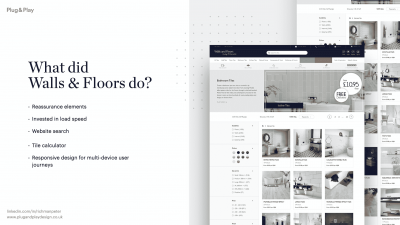
They sell to the industry as well as direct to the consumer. The key thing to bring your attention to here as an eCommerce website is having those category, subcategory and product pages highly optimised for Google and having lots of reassurance elements across the site.
For example under the main menu we implemented a reassurance banner that contains their free delivery policy, their Trust Pilot reviews and scores, and their no quibble returns guarantee. These are all things that are going to encourage visitors to convert on their website.
They invested massively in load speed and because it was a Magento website, they invested in Varnish Cache which massively improves the performance, before putting it on a CDN. So investing in speed like Google does, like Amazon does, like ASOS does makes a massive difference.
Also the way that people buy the product – people tend to buy tiles by the square meter or square foot and so when people are looking to buy, they’re buying it in a way they’re more familiar with rather than by the pack.
So Walls + Floors built a highly optimised site that is fast, with core reassurance elements throughout, with highly optimised landing pages based on specific search terms.
Paxton Access Control – Channel marketing strategy
And then we have the channel focused business models. The interesting thing about these is that on the face of it you wouldn’t think that there was much opportunity for digital marketing.
But actually these businesses, and we’re using Paxton here as an example, have products that they may not be selling online, or even to the end buyer. However their digital marketing can be very effective.
Paxton have a b2b2c model. They have the end consumer or business in their case who is looking to buy an access control solution for their property. They’ll buy that eventually from an installer. The installer is likely to buy it from a distributor or a trade counter and it is Paxton who manufactures and delivers the products to them.
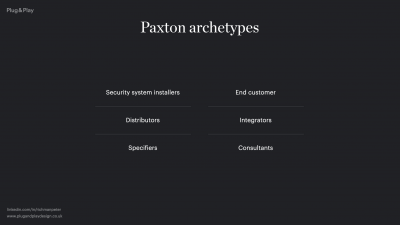
So really their marketing can only be focused on a couple of areas.
Their product and how they differentiate the product and promote it as the product of choice. But more than that, the people on the ground actually make a difference to what the end user is buying. If the installer is going to recommend something, how does Paxton ensure that it’s their products and solutions being recommended?
So this business, to give you an idea, has about 300 people within the company. They operate in 8 territories and we went from a position where they had 13 different websites across these different territories, in different languages, and we harmonised them into 1 WordPress website.
By doing so, we were able to harmonise the messaging for all of Paxton’s different archetypes into 1 place. The different archetypes such as installers, distributors, specifiers, end customers, integrators and consultants were all important, but there was one hero.
The hero in Paxton’s case is the installer. They’re the ones who go into a building that needs access control, they see what’s needed and then make a recommendation for a product. For Paxton, at the heart of their website was how can we be the easiest business to work with for an installer?
Paxton needed to consider how they could represent their products the right way for the customer. They needed to get their products to market and make the customers want the product- obviously very important. But how could they turn their installer network into advocates of their products? These installers aren’t wedded to Paxton and they sell lots of different access control systems and solutions from lots of different businesses. How could we make Paxton the company of choice?
And what Paxton did was they focused on how they could enable their customers to win more business. How do we improve the support they get? So the entire website is focused on the installer archetype and delivering the best possible service to them.
We did this by providing the internal marketing team with a flexible content management system based on WordPress. This enabled them to manage and edit the website which now has in the region of 5000 pages.
Paxton’s digital strategy has been a huge success, but there are examples where a single website to target all of your archetypes isn’t the right thing to do – and that’s very true for house builders.
Thakeham – House builders
Thakeham, the example I’m going to use here, are house builders based in the South East. As a house builder they have lots of different types of communication to lots of different archetypes that isn’t really appropriate to go on the same website.
When we look at their archetypes, they want to be seen in a good light by all of them but it’s very difficult to say to an investor that we’re going to make you lots of money while telling land owners that they don’t want to pay that much and want to negotiate on the price. Or to say to investors that they’re going to build lots of houses but say to local neighbourhoods that we’re all about community building and we’re not going to bulldoze the countryside and put houses up everywhere.
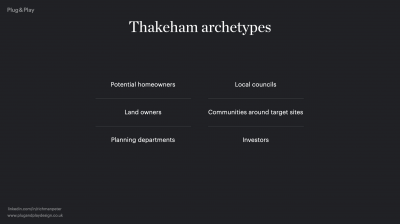
So it’s very difficult when you’re trying to manage lots of different types of communication as a business. These archetypes need different types of communication across different websites. What we were able to do was provide them with a range of different websites for those different archetypes and focused them on different keyword sets.
A lot of Thakeham’s advertising is offline and they also have hoardings around various building sites so they can have different URLs in different places as well.
Group is really focused on investors, Homes is focused on selling new homes, and Thakeham Client is focused around their building services for typically councils or housing associations who want to build large scale developments. Across all of their different archetypes they have a range of websites that are able to have clear communication with segmented messaging – and all of them rank highly in Google for relevant key search terms.
Key ways to implement digital strategy in the construction industry
We’ve covered quite a lot there but to cover some key points to take away:
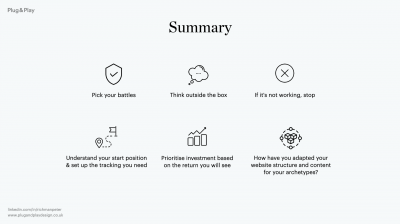
1. Pick your keyword battles
Pick your battles and have an honest conversation with yourself over how much time and money you can afford to spend on the battles. Are the battles too big? Are you picking too many? Are you picking a statistically valid way of selecting those battles? More importantly, which battles will you choose not to engage in? Business strategy and SEO are very similar in this way – it’s about choosing what not to do.
2. Think outside the box
Think outside of the box. Whether that is going after a bunch of high value but low quantity search terms, focusing in on a particular area of expertise, or where you’ve got a good portfolio or product fit.
3. Prioritise marketing activity based on ROI
Prioritise investment based on the return you’ll see. Use the customer acquisition cost model to model out whether you need to improve your market penetration or your conversion rate.
4. Build your website around your customer segments
And finally, make sure your website content and structure is adapted to your customer archetypes. Do you need 1 or many websites? Are you going to be really relevant and specific for a particular topic or do you need more of an overview for lots of different services?
Thank you very much.
If you would like a free consultation to discuss how you can implement a digital marketing strategy within your business, contact our team at [email protected] or call us on 0203 0111 641.
Related articles:
17 Best Architect Websites of 2024
Managing Internal SEO Stakeholders
Identifying Your Target Keywords With Searcher Intent
